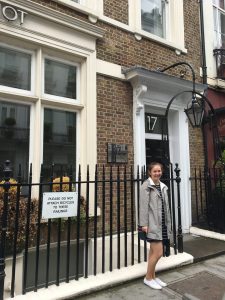By Jenna Fleming ’16
In September #TeamPeirs celebrated our two-year anniversary of going live. As anniversaries are a time for reflection, we thought we would contribute a few pieces on what #TheStaff has taken away from working on Peirs. As we are in the midst of a crowdfunding campaign to get us over to France in March 2018, we thought it might be of interest to our readers to know what its like to work on this project.
I was first introduced to the H. J. C. Peirs collection as the Diane Werley Smith ‘73 Intern at Musselman Library during the summer of 2014. Initially, I expected that my involvement with the papers would be limited to the duration of that summer. In practice, my work on the resulting project remains one of the most influential, beneficial, and best experiences of my time at Gettysburg College.
First and foremost, being part of the Peirs project team has helped me to become a better historian. We all know that primary sources are the best for historical research, but working with the collection clarified to me the true privilege of having access to a largely unexplored primary source. As the first person to read the letters comprehensively, I had the opportunity and the challenge of constructing a preliminary narrative around them, developing a direct context that would help us understand the people, places, and things they referenced casually or extensively. There was no guide to the collection, no source about Peirs and his experience of the war. I was the one creating the guide and writing the source, and it was so exciting. Of course, so much of my work was dependent upon other resources, including the research of established historians, but it was on me to first seek out and then piece together that information.

Awestruck at the Loos Memorial on 28 June 2016, three days before the centenary of the opening of the Battle of the Somme. Photo by Amy Lucadamo.
Through working with this collection, I gained a much more complete understanding of what a truly comprehensive look at history is; we took as holistic an approach as we could to building the narrative around these letters. Before working on the project, I never would have seen myself as a military historian. As time went on, I came to see the letters as an example of a personal history, a collected history, a war history, a political history, a social history. Like any manuscript collection, the Peirs papers are complete but fragmented, simultaneously offering both a partial explanation and a self-sufficient set. We approached the letters chronologically, thematically, sometimes restricting ourselves to just what they told us, at others looking specifically for what they didn’t. One of the biggest takeaways from my Historical Methods class (History 300 with Professor Magdalena Sánchez) was the perfection and imperfection of historical sources. Just as we had discussed in the classroom, I was able to read the Peirs papers with and against the grain in as many directions as I could think of. I had the time, the training, and the support to conduct a thorough historical investigation and build a complete historical understanding – both of which I have had the joy of watching grow over time.
My involvement with the Peirs project taught me to be a better archivist as well. As the Smith Intern, I was able to practice some of the skills that seem basic to me now, but are integral to the work of any archivist. I did the processing – arrangement and description – for the collection, though it was so well-cared-for that it needed very little of either. I did high-quality imaging for each page of each document, learning about digitization tools and digital preservation along the way. I collected metadata for every item in the collection and even helped to develop the schema we used to conceptualize, categorize, and record that information. I transcribed every word of the letters, refining the all-important technical skills of reading, researching, and deciphering, learning to recognize which shapes of hyphens Jack intended as commas and which served as periods. I documented my processes, creating, testing, and refining my own workflow. I could not have done any of this without the guidance and advice of the Special Collections staff, but for all the help they provided, they also gave me the freedom to do archival work on my own. This experience was absolutely invaluable as an undergraduate, and even more so for me due to the nature of the collection.
I will echo some of the other Team Peirs members in saying that the personal aspects of this project have been for me some of the most lasting and significant. I have had the opportunity to work collaboratively and collegially with people I admire and respect, and I have consistently been impressed and encouraged by their ideas, their commitment, and their enthusiasm for learning. The best experience has been one that I think is unique to our discipline of history: that of making a connection with and getting to know someone from the past, someone who I will never meet in person but who has unwittingly shared with me more than he could have ever expected. Jack Peirs was a courageous, tenacious, deeply flawed individual who lived through a conflict so destructive and complex that we are still struggling to understand it a century later. Despite and because of his imperfections, he shows us so much about fortitude, solidarity, leadership, and humility, and his words have been instrumental to my study and understanding of history.

